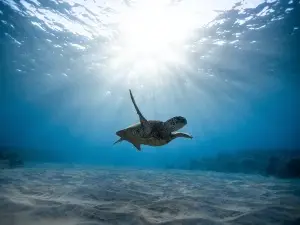
If you’re a turtle owner then you are likely paying very close attention to what your pet turtle is doing, so you’ll quickly notice if your pet starts making bubbles, and you may wonder why.
This article is a look into why your turtle seems to be making bubbles
Table of Contents
Why is my turtle making bubbles?
The smallest thing that your turtle does may make you wonder about the health of your pet, something as small as the animal making bubbles may worry you
Here is why your pet turtle may be making bubbles:
Swimming deep:
One of the simplest reasons why your pet turtle may be releasing bubbles is that the animal is diving deeper into the water.
These animals love swimming, and they love diving, and it is normal for these animals to release water as they dive deep into a body of water.
The releasing of water helps lower the animal’s buoyancy, the less air in the animal the deeper the turtle will get
They’ve learned to do this because if they were to float away in the sea, while in the wild, they would be more vulnerable to presentation so they sink as low as they can go to keep predators from catching them.
What to do:
This is entirely normal behavior and isn’t something that you’d need to worry about, as long as the animal is healthy overall, as long as it is swimming, eating, and behaving normally then your pet should be fine.
Respiratory infection:
Another reason why your pet may be making bubbles may be because the animal has a respiratory infection.
In this case, bubbles will form at the turtle’s nostrils or around the animal’s eyes. The turtle will produce bubbles of mucus and this will look similar to what a human produces when we are sick
This condition is common but it can be deadly, it can turn into pneumonia if the disease is not treated.
Other signs of this condition in your pet turtle include the animal floating oddly ie: to one side, in the water. This happens because the infection affects the animal’s lungs and thus causes buoyancy issues.
Other signs of this condition include gasping when breathing (to try to get more air in), an extending of the neck when breathing, wheezing, odd when breathing, yawning, preferring to bask more often than usual, a lack of appetite, and a lack of energy.
What to do:
If you see signs of this condition in your pet then you’d need to book a consultation with a vet. Get your pet to the vet right away, your pet’s condition will get worse, and your pet can get very sick, if not treated.
This condition requires antibiotics, your vet can prescribe these. If you don’t have experience with sick turtles, if you aren’t a vet, then it isn’t recommended that you give your pet antibiotics with no advice from the vet as these medications can carry risks to the animal’s health
If you can’t immediately get your pet to the vet then raise your pet’s water temperature to 83.6 – 84.6 degrees F, increasing the ambient temperature will also help fight off the infection until you get your pet to the vet.

